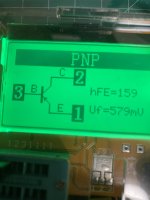Draws about 1.5 amps, unloaded. No lights come on whatsoever.
TL494C chip DC voltages
1. 0
2. .56
3. .07
4. 0
5. .01
6. 0
7. 0
8. 1.9
9. .05
10. .05
11. 1.9
12. 1.2
13. .575
14. .575
15. .575
16. 0
I pulled the data sheet on the 494 and was expected 5 V on pin 14 and 12 V on pin 12. This amp was built in December 2013 according to the tag. The only PG diagram I can find online is a different unit altogether from 1995.
Thanks for any help or suggestions.
TL494C chip DC voltages
1. 0
2. .56
3. .07
4. 0
5. .01
6. 0
7. 0
8. 1.9
9. .05
10. .05
11. 1.9
12. 1.2
13. .575
14. .575
15. .575
16. 0
I pulled the data sheet on the 494 and was expected 5 V on pin 14 and 12 V on pin 12. This amp was built in December 2013 according to the tag. The only PG diagram I can find online is a different unit altogether from 1995.
Thanks for any help or suggestions.
Where did you find the diagram online?
PG amps typically supply pin 12 with voltage through a PNP transistor that has it's emitter directly connected to B+. Find that transistor.
PG amps typically supply pin 12 with voltage through a PNP transistor that has it's emitter directly connected to B+. Find that transistor.
Hey Perry,
I found the diagram at Electrotanya.
I traced back from pin 12, through one resistor and one diode to a 649A transistor. It's emitter traces directly to the DC input. However, when I measured its voltages, the emitter only had 4.3 volts. I then verified at the DC input that something is loading down the 12 volt input to 4.3 volts. Current draw is about 1.5 A.
I found the diagram at Electrotanya.
I traced back from pin 12, through one resistor and one diode to a 649A transistor. It's emitter traces directly to the DC input. However, when I measured its voltages, the emitter only had 4.3 volts. I then verified at the DC input that something is loading down the 12 volt input to 4.3 volts. Current draw is about 1.5 A.
Base was 3.7 volts.
Not hot at all. Comfortable to the touch. Reading room temperature with the digital laser thermometer.
Not hot at all. Comfortable to the touch. Reading room temperature with the digital laser thermometer.
You can jump the transistor location from collector to emitter to allow further testing. Be careful when applying power in case there is a shorted component being fed by that transistor.
I don't trust those testers. The BE junction is essentially a diode and more than about a volt difference means that that junction is damaged.
I don't trust those testers. The BE junction is essentially a diode and more than about a volt difference means that that junction is damaged.
I am not sure. I had a fully charged, known good battery connected and was getting the same voltage reading on B+. Battery read in excess of 12 volts unconnected and then B+ read 4.3 volts (approx.) connected.
I do not know enough about these circuits to isolate the cause, but it feels like something is definitely loading down the input voltage. Obviously, it's not a dead short.
Is there a circuit I could study somewhere that is representative of this type of amplifier power distribution? To be honest, I don't even know which all components are fed B+ directly in these amps. I think I am spoiled because in my other electronics work, I rely heavily on schematics and diagrams.
I appreciate all of your help. Obviously, I am hungry for information.
I do not know enough about these circuits to isolate the cause, but it feels like something is definitely loading down the input voltage. Obviously, it's not a dead short.
Is there a circuit I could study somewhere that is representative of this type of amplifier power distribution? To be honest, I don't even know which all components are fed B+ directly in these amps. I think I am spoiled because in my other electronics work, I rely heavily on schematics and diagrams.
I appreciate all of your help. Obviously, I am hungry for information.
Install a 10 amp fuse in the B+ line of the amp. If it drags the voltage down without blowing the fuse, the battery is bad, assuming that you're measuring the battery voltage directly across battery terminals.
I don't know specifically what information you're looking for but page 20 of my bcae1.com site is a good start.
I don't know specifically what information you're looking for but page 20 of my bcae1.com site is a good start.
- Home
- General Interest
- Car Audio
- Phoenix Gold RX600.5 Will not power on
